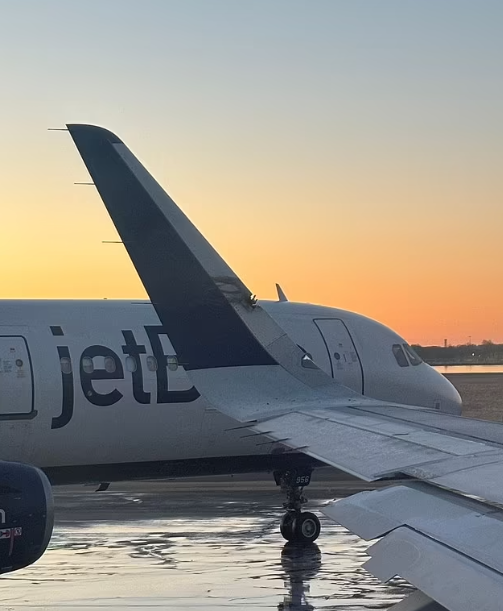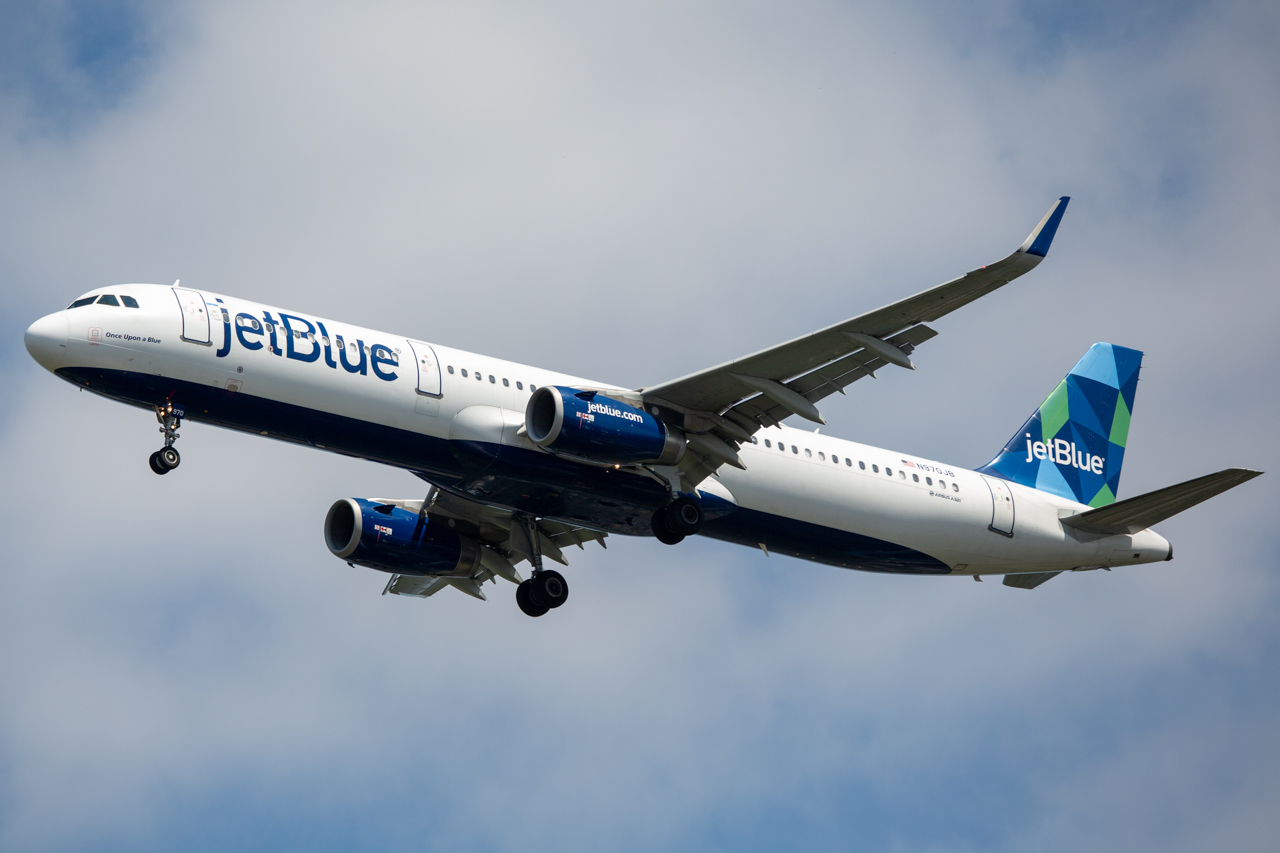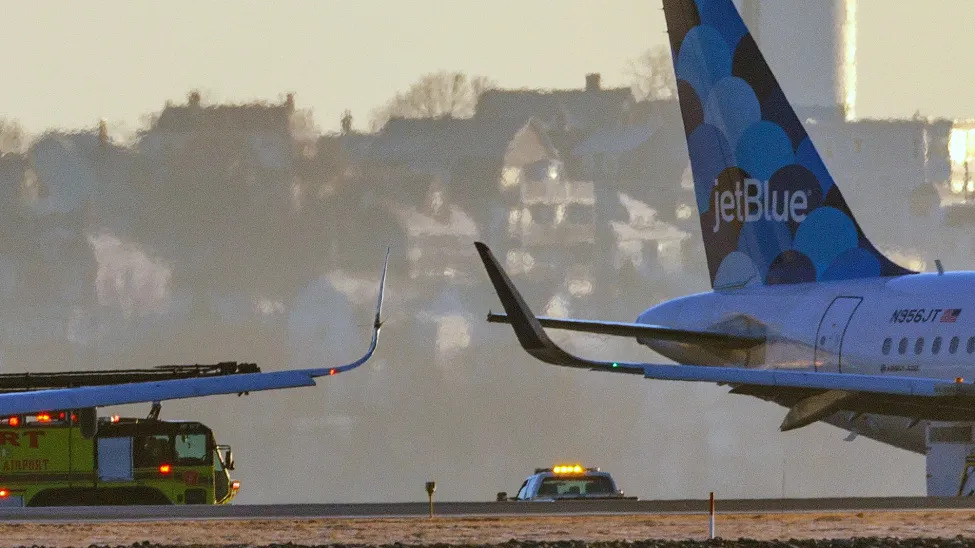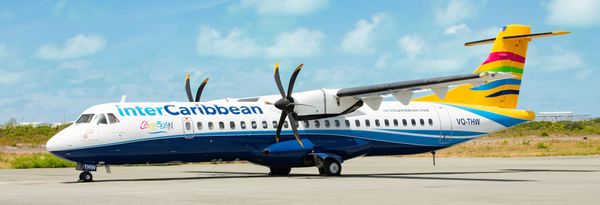Passengers at Boston Logan International Airport(BOS) witnessed a heart-stopping incident after two JetBlue Airbus A321s, heading for Las Vegas and Orlando, collided while taxiing to de-icing pads. While no injuries were reported, the event raises questions about airport safety procedures and the potential for human error in even the most routine operations.

The Incident
The incident unfolded around 6:40 a.m. local time on February 8. When JetBlue Flight 777, preparing for its Las Vegas departure, was entering the designated de-icing lane before taking off, clipped its winglet with the horizontal stabilizer of Flight 6551, bound for Orlando. Both aircraft sustained damage, primarily to the winglet and horizontal stabilizer.
One passenger said, “The plane does jolt a little bit, we definitely feel the plane move,”. She also added, “The captain comes over the intercom and says, ‘We felt that just so you all know.’”

Despite the jarring impact, all passengers and crew onboard both planes emerged unharmed. Both flights were understandably delayed, with passengers being rebooked on alternative aircraft. JetBlue, prioritizing safety, immediately grounded both planes for thorough inspections and repairs.
“Safety is JetBlue’s priority, and we will work to determine how and why this incident occurred,” JetBlue said in a statement.

While investigations are ongoing, initial reports suggest human error as a possible contributing factor. The Federal Aviation Administration (FAA) is currently leading the investigation and examining factors like ground control communication, weather conditions, and pilot visibility. Additionally, JetBlue will likely conduct an internal review to identify any potential procedural shortcomings or gaps in communication.
The Captain explained, “that another plane that was going to de-ice came into contact with ours.”
Incidents like this, though fortunately rare, serve as stark reminders of the complex environment and intricate choreography involved in air travel. Even at seemingly mundane stages like taxiing and de-icing, maintaining clear communication and adhering to strict protocols are crucial.

How Future Incidents Can Be Avoided
There are multiple ways to avoid this situation:
- Ensuring unambiguous instructions from ground controllers to pilots is paramount. Fatigue, distractions, and miscommunication can have disastrous consequences. Robust training and standardized procedures can help mitigate these risks.
- The layout and signage of taxiways and de-icing pads are crucial in preventing collisions. Clear markings, adequate spacing between aircraft, and well-defined traffic patterns can improve situational awareness for pilots and ground personnel.
- Advanced technologies like ground radar systems and automated taxiing aids can provide valuable real-time guidance and potentially prevent human error. While not foolproof, they can offer an additional layer of safety.
Beyond immediate safety concerns, the incident also raises questions about passenger experience and potential disruptions. While JetBlue handled the rebooking process promptly, any airport incident can lead to delays, missed connections, and inconvenience for travelers. Airlines and airport authorities must strive to minimize these disruptions by having transparent communication strategies, contingency plans, and efficient rebooking procedures.

The JetBlue brush-up at Boston Logan is a wake-up call for the aviation industry. While safety remains the top priority, minimizing disruptions and ensuring a smooth travel experience for passengers is equally essential. Continuous improvement in communication, infrastructure, technology integration, and operational procedures ensures skies remain safe, efficient, and passenger-friendly.
Lufthansa Technik Unveils Major ACJ318 Elite Upgrade Program » Global Drone Wingman Programs Accelerate Toward Critical 2026 Milestones as Competition Intensifies » AeroXplorer Named Official Media Partner for Airliners International 2026 in Denver »
Comments (0)
Add Your Comment
SHARE
TAGS
NEWS JetBlue Airbus A321 Boston Massachusetts Collision Incident SafetyRECENTLY PUBLISHED
 interCaribbean Airways Expands Barbados Hub with Five New Non-Stop Routes
In a significant move to solidify its position as the premier regional connector, interCaribbean Airways has officially announced a major network expansion from its Southern Caribbean hub at Grantley Adams International Airport (BGI). Starting March 8, 2026, the airline will launch five new non-stop routes, bringing its total number of direct destinations from Barbados to 12.
ROUTES
READ MORE »
interCaribbean Airways Expands Barbados Hub with Five New Non-Stop Routes
In a significant move to solidify its position as the premier regional connector, interCaribbean Airways has officially announced a major network expansion from its Southern Caribbean hub at Grantley Adams International Airport (BGI). Starting March 8, 2026, the airline will launch five new non-stop routes, bringing its total number of direct destinations from Barbados to 12.
ROUTES
READ MORE »
 Alaska Airlines and LATAM Formally Dissolve Codeshare Partnership
Marking the end of an era in Pan-American aviation, Alaska Airlines has officially terminated its nearly decade-old codeshare and loyalty partnership with LATAM Airlines Group. The split, finalised in a formal filing to the U.S. Department of Transportation (DOT) on December 29, 2025, follows a phased winding down of reciprocal benefits that began earlier in the autumn.
NEWS
READ MORE »
Alaska Airlines and LATAM Formally Dissolve Codeshare Partnership
Marking the end of an era in Pan-American aviation, Alaska Airlines has officially terminated its nearly decade-old codeshare and loyalty partnership with LATAM Airlines Group. The split, finalised in a formal filing to the U.S. Department of Transportation (DOT) on December 29, 2025, follows a phased winding down of reciprocal benefits that began earlier in the autumn.
NEWS
READ MORE »
 Global Drone Wingman Programs Accelerate Toward Critical 2026 Milestones as Competition Intensifies
The race to field operational autonomous "loyal wingman" drones is accelerating into overdrive as 2026 approaches, with the United States Air Force poised to make critical production decisions, Australia demonstrating combat capabilities with live weapons, and rival programs in Europe and Asia rapidly maturing.
NEWS
READ MORE »
Global Drone Wingman Programs Accelerate Toward Critical 2026 Milestones as Competition Intensifies
The race to field operational autonomous "loyal wingman" drones is accelerating into overdrive as 2026 approaches, with the United States Air Force poised to make critical production decisions, Australia demonstrating combat capabilities with live weapons, and rival programs in Europe and Asia rapidly maturing.
NEWS
READ MORE »



